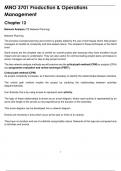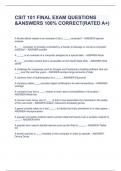MNO 3701 Production & Operations
Management
Chapter 12
Network Analysis (TB Network Planning)
Network Planning
The process of project planning and control is greatly aided by the use of techniques which help project
managers to handle its complexity and time-based nature. The simplest of these techniques is the Gantt
chart
Gantt charts are the simplest way to exhibit an overall project plan because they have excellent visual
impact and are easy to understand. They are also useful for communicating project plans and status to
senior managers as well as for day-to-day project control.
The two network analysis methods we will examine are the critical path method (CPM) or analysis (CPA)
and programme evaluation and review technique (PERT).
Critical path method (CPM)
As project complexity increases, so it becomes necessary to identify the relationships between activities.
The critical path method models the project by clarifying the relationships between activities
diagrammatically.
Can illustrate this is by using arrows to represent each activity.
The logic of these relationships is shown as an arrow diagram, where each activity is represented by an
arrow (the length of the arrows is not proportional to the duration of the activities).
This arrow diagram can be developed into a network diagram
Events are moments in time which occur at the start or finish of an activity.
They have no duration and are of a definite recognizable nature. Networks of this type are composed only
of activities and events
1
, The rules for drawing this type of network diagram are fairly straightforward:
Rule 1 An event cannot be reached until all activities leading to it are complete.
Rule 2 No activity can start until its tail event is reached.
Rule 3 No two activities can have the same head and tail events. They must be drawn using a dummy
activity.
These have no duration and are usually shown as a dotted-line arrow
The critical path
In all network diagrams where the activities have some parallel relationships, there will be more than one
sequence of activities which will lead from the start to the end of the project.
These sequences of activities are called paths through the network.
Each path will have a total duration which is the sum of all its activities. The path which has the longest
sequence of activities is called the critical path of the network
It is called the critical path because any delay in any of the activities on this path will delay the whole
project.
By drawing the network diagram we can:
identify which are the particularly important activities;
calculate the duration of the whole project
Calculating float
The flexibility to change the timings of activities, which is inherent in various parts of a project, as float.
We can use the network diagram to calculate this for each activity.
The procedure is relatively simple:
1. Calculate the earliest and latest event times for each event. The earliest event time (EET) is the
very earliest the event could possibly occur if all preceding activities are completed as early as
possible. The latest event time (LET) is the latest time that the event could possibly take place
without delaying the whole project.
2
Management
Chapter 12
Network Analysis (TB Network Planning)
Network Planning
The process of project planning and control is greatly aided by the use of techniques which help project
managers to handle its complexity and time-based nature. The simplest of these techniques is the Gantt
chart
Gantt charts are the simplest way to exhibit an overall project plan because they have excellent visual
impact and are easy to understand. They are also useful for communicating project plans and status to
senior managers as well as for day-to-day project control.
The two network analysis methods we will examine are the critical path method (CPM) or analysis (CPA)
and programme evaluation and review technique (PERT).
Critical path method (CPM)
As project complexity increases, so it becomes necessary to identify the relationships between activities.
The critical path method models the project by clarifying the relationships between activities
diagrammatically.
Can illustrate this is by using arrows to represent each activity.
The logic of these relationships is shown as an arrow diagram, where each activity is represented by an
arrow (the length of the arrows is not proportional to the duration of the activities).
This arrow diagram can be developed into a network diagram
Events are moments in time which occur at the start or finish of an activity.
They have no duration and are of a definite recognizable nature. Networks of this type are composed only
of activities and events
1
, The rules for drawing this type of network diagram are fairly straightforward:
Rule 1 An event cannot be reached until all activities leading to it are complete.
Rule 2 No activity can start until its tail event is reached.
Rule 3 No two activities can have the same head and tail events. They must be drawn using a dummy
activity.
These have no duration and are usually shown as a dotted-line arrow
The critical path
In all network diagrams where the activities have some parallel relationships, there will be more than one
sequence of activities which will lead from the start to the end of the project.
These sequences of activities are called paths through the network.
Each path will have a total duration which is the sum of all its activities. The path which has the longest
sequence of activities is called the critical path of the network
It is called the critical path because any delay in any of the activities on this path will delay the whole
project.
By drawing the network diagram we can:
identify which are the particularly important activities;
calculate the duration of the whole project
Calculating float
The flexibility to change the timings of activities, which is inherent in various parts of a project, as float.
We can use the network diagram to calculate this for each activity.
The procedure is relatively simple:
1. Calculate the earliest and latest event times for each event. The earliest event time (EET) is the
very earliest the event could possibly occur if all preceding activities are completed as early as
possible. The latest event time (LET) is the latest time that the event could possibly take place
without delaying the whole project.
2



